https://www.foxnews.com/politics/failed-climate-change-predictions
By Sam Dorman | Fox News
Rep. Alexandria Ocasio-Cortez recently suggested Miami would disappear in “a few years” due to climate change. The United Nations is convening a “Climate Action Summit” next week. And climate activist Greta Thunberg is on Capitol Hill this week telling lawmakers they must act soon.
But while data from NASA and other top research agencies confirms global temperatures are indeed rising, a newly compiled retrospective indicates the doomsday rhetoric is perhaps more overheated.
The conservative-leaning Competitive Enterprise Institute has put together a lengthy compilation of apocalyptic predictions dating back decades that did not come to pass, timed as Democratic presidential candidates and climate activists refocus attention on the issue.
The dire predictions, often repeated in the media, warned of a variety of impending disasters – famine, drought, an ice age, and even disappearing nations – if the world failed to act on climate change.
An Associated Press headline from 1989 read “Rising seas could obliterate nations: U.N. officials.” The article detailed a U.N. environmental official warning that entire nations would be eliminated if the world failed to reverse warming by 2000.
Then there were the fears that the world would experience a never-ending “cooling trend in the Northern Hemisphere.” That claim came from an “international team of specialists” cited by The New York Times in 1978.
Just years prior, Time magazine echoed other media outlets in suggesting that “another ice age” was imminent. “Telltale signs are everywhere — from the unexpected persistence and thickness of pack ice in the waters around Iceland to the southward migration of a warmth-loving creature like the armadillo from the Midwest,” the magazine warned in 1974. The Guardian similarly warned in 1974 that “Space satellites show new Ice Age coming fast.”
In 1970, The Boston Globe ran the headline, “Scientist predicts a new ice age by 21st century.” The Washington Post, for its part, published a Columbia University scientist’s claim that the world could be “as little as 50 or 60 years away from a disastrous new ice age.”
Some of the more dire predictions came from Paul Ehrlich, a biologist who famously urged population control to mitigate the impacts of humans on the environment. Ehrlich, in 1969, warned that “everybody” would “disappear in a cloud of blue steam in 20 years,” The New York Times reported.
According to The Salt Lake Tribune, Ehrlich, warning of a “disastrous” famine,” urged placing “sterilizing agents into staple foods and drinking water.”
Those predictions were made around the time former President Richard Nixon created the Environmental Protection Agency. Since then, the U.S. has adopted a series of environmental reforms aimed at limiting emissions.
Years after those initial predictions, media outlets and politicians continue to teem with claims of apocalyptic scenarios resulting from climate change.
Earlier this month, leading Democratic presidential candidates held a town hall on the issue and warned about the “existential” threat posed by a changing climate. Before the end of the month, 2020 candidates are expected to have another climate forum at Georgetown University.
CEI’s report came just before the U.N. Climate Action Summit on Sept. 23, an event that promises to “spark the transformation that is urgently needed and propel action that will benefit everyone.”
It also came a week after Rep. Ocasio-Cortez, D-N.Y., warned that Miami would be gone in a “few years” because of climate change. She was responding to critics of her ambitious “Green New Deal,” which seeks to reach net-zero emissions within just decades.
Ocasio-Cortez, whose plan has been endorsed by leading presidential candidates, previously joked that the world would end in 12 years if it didn’t address climate change. But short-term predictions weren’t a laughing matter in the years following “An Inconvenient Truth,” a documentary produced by former Vice President Al Gore.
In 2008, ABC released an ominous video about what the world would look like in 2015. As the video warned about rising sea levels, a graphic showed significant portions of New York City engulfed by water. Gore himself famously predicted in the early 2000s that Arctic ice could be gone within seven years. At the end of seven years, Arctic ice had undergone a period of expansion, though recently it has been melting at a quicker pace.
#
Full CEI report here:
SUMMARY
Modern doomsayers have been predicting climate and environmental disaster since the 1960s. They continue to do so today.
None of the apocalyptic predictions with due dates as of today have come true.
What follows is a collection of notably wild predictions from notable people in government and science.
More than merely spotlighting the failed predictions, this collection shows that the makers of failed apocalyptic predictions often are individuals holding respected positions in government and science.
While such predictions have been and continue to be enthusiastically reported by a media eager for sensational headlines, the failures are typically not revisited.
1967: ‘Dire famine by 1975.’
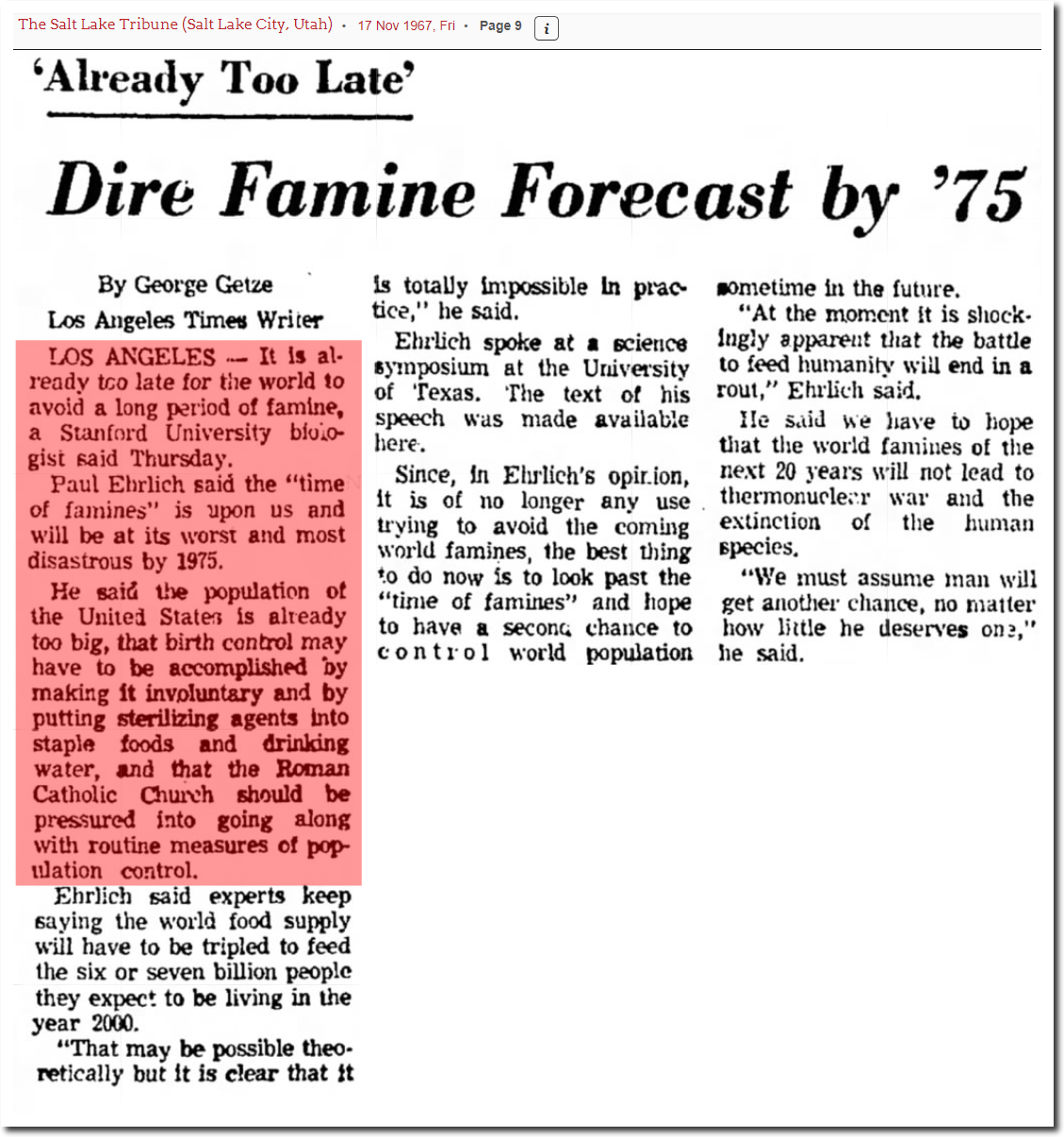
Source: Salt Lake Tribune, November 17, 1967
1969: ‘Everyone will disappear in a cloud of blue steam by 1989.’
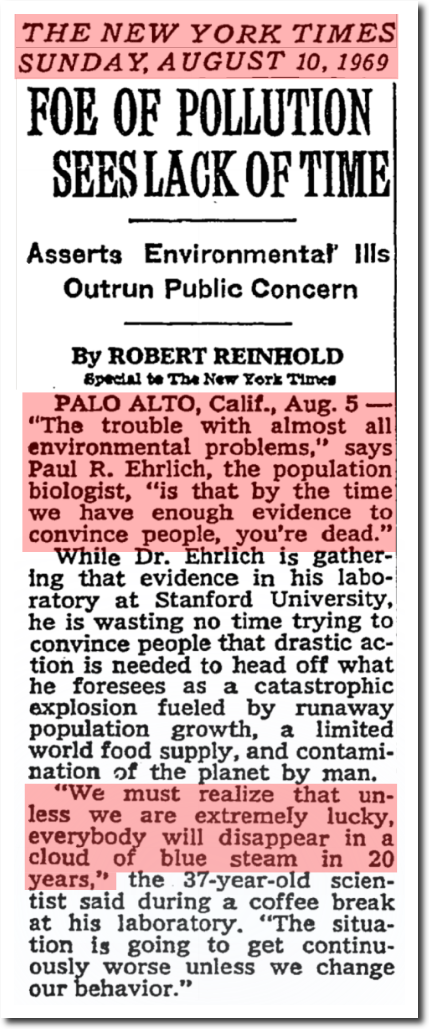
Source: New York Times, August 10 1969
1970: Ice age by 2000

Source: Boston Globe, April 16, 1970
1970: ‘America subject to water rationing by 1974 and food rationing by 1980.’
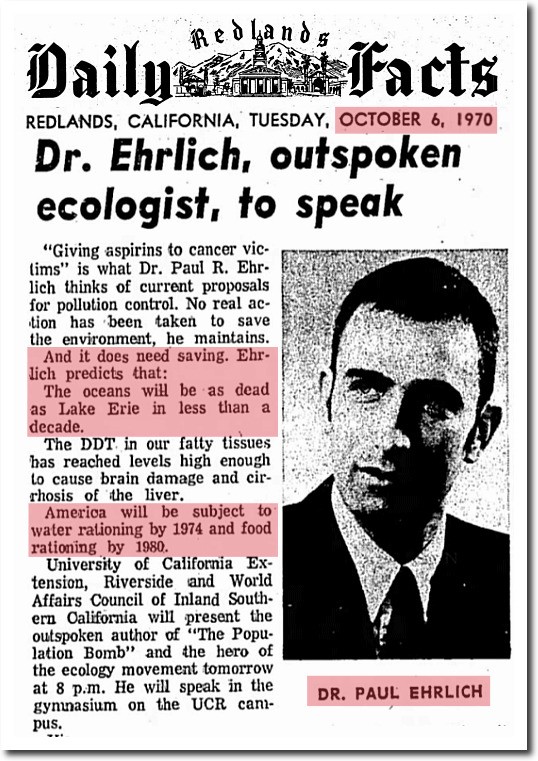
Source: Redlands Daily Facts, October 6, 1970
1971: ‘New Ice Age Coming’

Source: Washington Post, July 9, 1971
1972: New ice age by 2070


1974: ‘New Ice Age Coming Fast’

Source: The Guardian, January 29, 1974
1974: ‘Another Ice Age?’

1974: Ozone Depletion a ‘Great Peril to Life’

But no such ‘great peril to life’ has been observed as the so-called ‘ozone hole’ remains:

Sources: Headline
1976: ‘The Cooling’

Source: New York Times Book Review, July 18, 1976
1980: ‘Acid Rain Kills Life in Lakes’
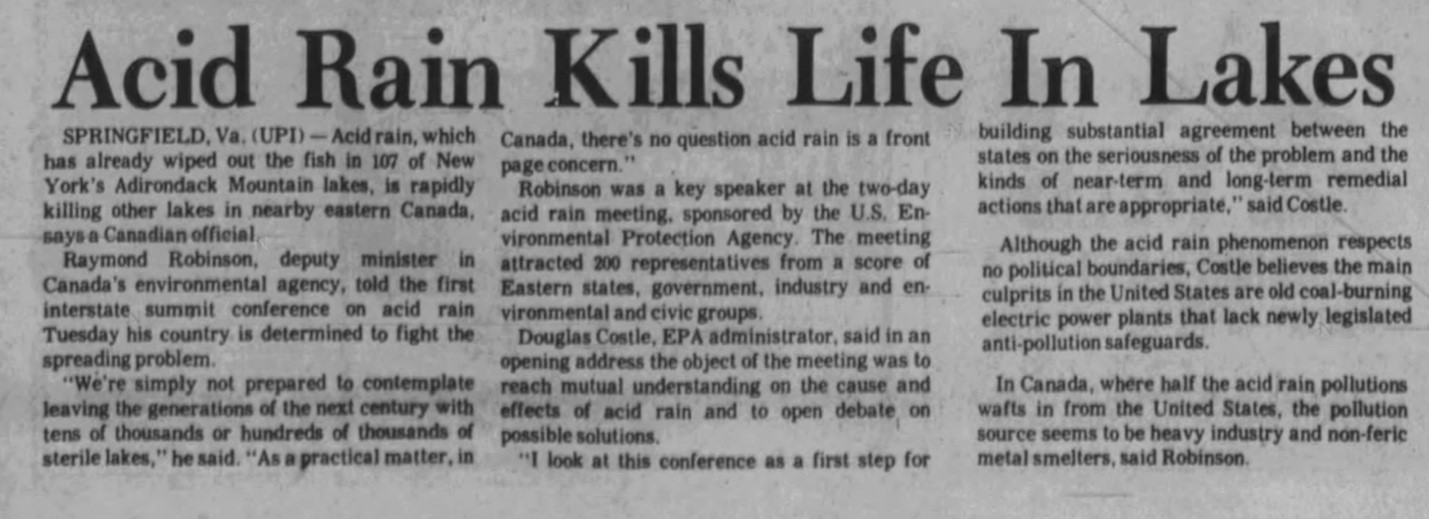
Noblesville Ledger (Noblesville, IN) April 9, 1980
But 10 years later, the US government program formed to study acid rain concluded:

Associated Press, September 6, 1990
1978: ‘No End in Sight’ to 30-Year Cooling Trend

Source: New York Times, January 5, 1978
But according to NASA satellite data there is a slight warming trend since 1979.

1988: James Hansen forecasts increase regional drought in 1990s

But the last really dry year in the Midwest was 1988, and recent years have been record wet.

Source: RealClimateScience.com
1988: Washington DC days over 90F to from 35 to 85

But the number of hot days in the DC area peaked in 1911, and have been declining ever since.

Source: RealClimateScience.com
1988: Maldives completely under water in 30 years

Source: Agence France Press, September 26, 1988
1989: Rising seas to ‘obliterate’ nations by 2000

Source: Associated Press, June 30, 1989
1989: New York City’s West Side Highway underwater by 2019
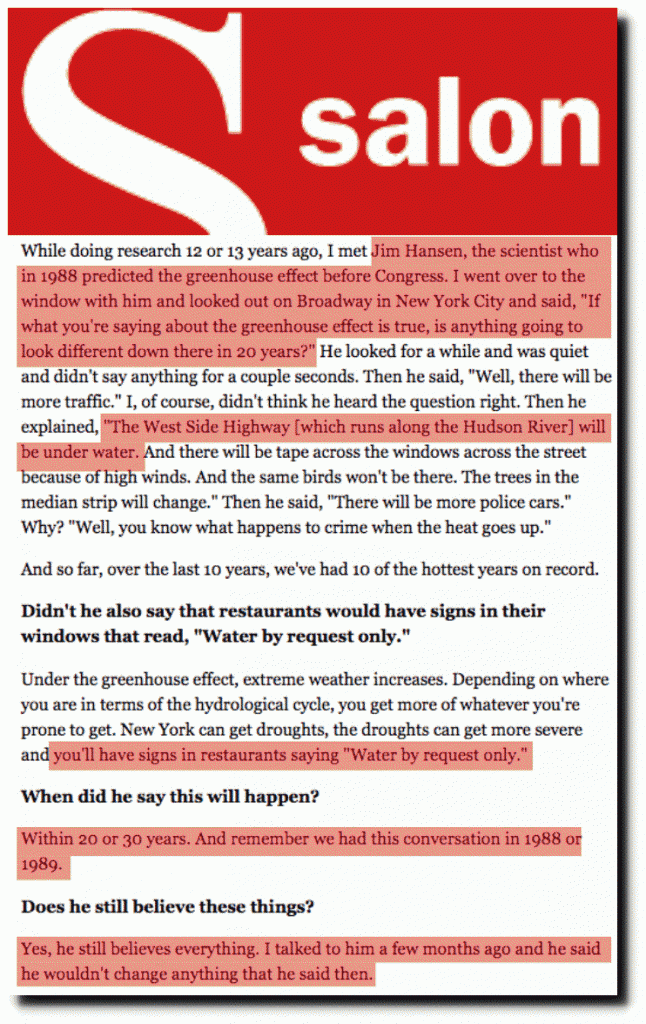
Source: Salon.com, October 23, 2001
1995 to Present: Climate Model Failure

2000: ‘Children won’t know what snow is.’


Source: The Independent, March 20, 2000
2002: Famine in 10 years

Source: The Guardian, December 23, 2002
2004: Britain to have Siberian climate by 2020

Source: The Guardian, February 21, 2004
2008: Arctic will be ice-free by 2018
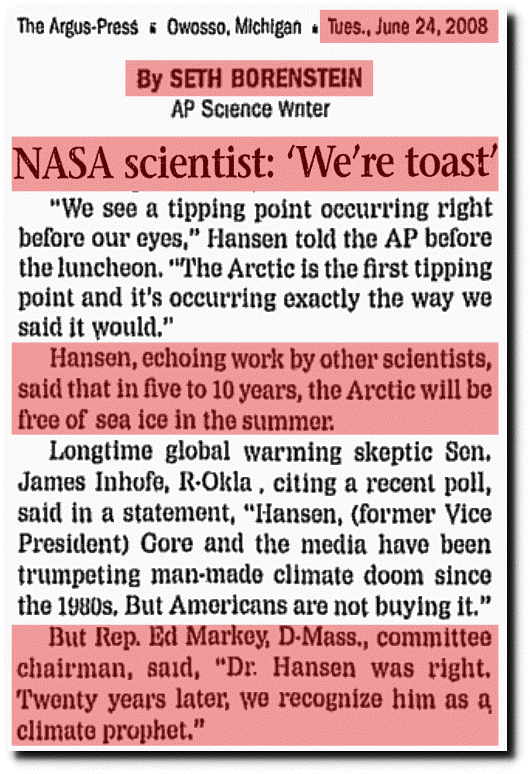
Source: Associated Press, June 24, 2008
2008: Al Gore warns of ice-free Arctic by 2013

But… it’s still there:

Source: WattsUpWithThat.com, December 16, 2018
2009: Prince Charles says only 8 years to save the planet

Source: The Independent, July 9, 2009
2009: UK prime minister says 50 days to ‘save the planet from catastrophe’

Source: The Independent: October 20, 2009
2009: Arctic ice-free by 2014

Source: USA Today, December 14, 2009
2013: Arctic ice-free by 2015

Source: The Guardian, July 24, 2013
The paper: https://www.nature.com/articles/s41467-017-02550-9 (open access)
Gas hydrate dissociation off Svalbard induced by isostatic rebound rather than global warming
Abstract
Methane seepage from the upper continental slopes of Western Svalbard has previously been attributed to gas hydrate dissociation induced by anthropogenic warming of ambient bottom waters. Here we show that sediment cores drilled off Prins Karls Foreland contain freshwater from dissociating hydrates. However, our modeling indicates that the observed pore water freshening began around 8 ka BP when the rate of isostatic uplift outpaced eustatic sea-level rise. The resultant local shallowing and lowering of hydrostatic pressure forced gas hydrate dissociation and dissolved chloride depletions consistent with our geochemical analysis. Hence, we propose that hydrate dissociation was triggered by postglacial isostatic rebound rather than anthropogenic warming. Furthermore, we show that methane fluxes from dissociating hydrates were considerably smaller than present methane seepage rates implying that gas hydrates were not a major source of methane to the oceans, but rather acted as a dynamic seal, regulating methane release from deep geological reservoirs.
2013: Arctic ice-free by 2016

Source: The Guardian, December 9, 2013
2014: Only 500 days before ‘climate chaos’

But…





